 |
Site created 12/15/97.

page created: 9/22/10
 Barrie Maxwell - Main Page |
||
Classic Reviews Round-Up #64 and New Announcements
Welcome to the latest edition of Classic Coming Attractions. This outing offers some news about Sony's new manufactured-on-demand program, the usual update of new announcements of classic title releases, and the updated database of such releases. I also have 23 reviews for you this time. They include The House Across the Bay (from TCM); Deanna Durbin: The Music and Romance Collection and The Further Adventures of the Kettles (from TCM/Universal); Trouble in the Sky, Silver Lode, and New York Confidential (from VCI); TCM Spotlight: Errol Flynn Adventures (from Warner Bros.); The Lone Ranger and The Lone Ranger Rides Again serials (from The Serial Squadron); Yellowstone Kelly, Dogville Collection, The House on 56th Street, Give Me Your Heart, The Locket, None But the Lonely Heart, and The Devil's Doorway (from the Warner Archive); Have Gun - Will Travel: The Fourth Season, Volume Two (from Paramount); Bob Hope: Thanks for the Memories Collection (from Universal); Chicago (from Flicker Alley); The Offence and The Caretakers (from MGM/Create Space); and The Honeymooners Specials: Second Honeymoon and The Honeymooners Specials: Valentine Special (from MPI). I thought it was worth mentioning right up front that Sony has apparently jumped into the manufactured-on-demand (MOD) game in a big way. It's announced a "Screen Classics By Request" program at its Columbia Classics website that offers 100 Columbia titles never before on DVD, beginning this month. It will add further titles to the program each successive month and eventually offer a process for fans to suggest titles for release. Beyond stating that all titles will be based on the best quality masters available (many are listed as being newly remastered) and offering original poster art or stills on the packaging, there's no other specific information given on the program, but one assumes it will mirror the Warner Archive to a large degree. The discs are priced at $19.94 each via the Sony website (which doesn't allow shipping outside the U.S.), but are also available through Critics Choice and Deep Discount at slightly different prices. What this means for Sony's ambitious recent program of classic releases on pressed DVD is unclear, but along with a recent arrangement with Image for that company to release some Sony catalog items, this new initiative does give cause for concern. Here's the list of classic titles (pre-1975) available in the opening wave - a good blend of drama, westerns, war, comedy, noir, and British productions:
With all that to chew on, let's get on with the rest of the column. Classic Reviews The House Across the Bay is a TCM exclusive that, like an earlier set of six RKO rarities, is delivered on DVD-R. The film is one of the Walter Wanger productions originally distributed by United Artists and whose rights are currently controlled by Westchester Films, giving rise to speculation that other such titles (such as Trade Winds, I Married a Witch, etc. might appear on DVD via TCM also - Sundown is another Wanger film that has already been announced for release). 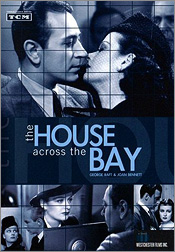
The House Across the Bay stars George Raft and Joan Bennett in a familiar tale of nightclub owner Steve Larwitt who plucks his future wife Brenda from the proverbial chorus line and tries to impress her by quickly expanding his interests. He runs afoul of rival racketeers and the law, and ends up in jail with a 10-year sentence when his wife is duped into testifying against him by his crooked lawyer (Lloyd Nolan) who is also after Brenda for himself. It's great to see this title made available commercially for it's a rarely seen yet thoroughly entertaining film that benefits from solid supporting work from Walter Pidgeon, Gladys George, and the aforementioned Nolan - not to mention a raft of character actors from the golden Age (Joe Sawyer, Joseph Crehan, Virginia Brissac, Cy Kendall, Pat O'Malley, etc.). Joan Bennett is particularly solid as Brenda, while Raft is asked to do little beyond his standard effort in such vehicles. It's a shame Raft never seemed to get or choose the sort of roles that would really stretch him. One sees the potential at times in the likes of They Drive by Night and Manpower - a couple of his Warner Bros. films. Speaking of Warners, that studio itself apparently considered filming the story The House Across the Bay was based on, with James Cagney and Marlene Dietrich considered for the leads, but that obviously never materialized. TCM's presentation, full frame as originally released is merely okay. The image is reasonably well delineated throughout, but suffers from an overall softness for the majority of the running time. Some reels do look brighter and sharper than others. The mono sound is in good shape with only some minor hiss apparent. Supplements comprise the typical TCM package of lobby card, poster, publicity and scene still reproductions; some trivia; and a good text article about the production taken from the TCM database. Recommended. Chicago (1927) is a terrific piece of melodrama with comic overtones that really illustrates the heights of polished popular entertainment that the silent film reached in its waning days. The film comes from Cecil B. DeMille's production comedy and was likely mainly directed by him (though signed by Frank Urson, as though DeMille thought the public might feel such tawdry tales were beneath the dignity of the man who directed King of Kings). 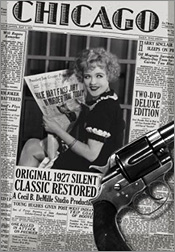
In it, it's the flapper era in Chicago and jazz-loving but shallow Roxie Hart (Phyllis Haver) has a doting husband in Victor Varconi. That's not enough for her though and she gets a little on the side from Eugene Pallette, but when he decides to dump Roxie, she kills him. She's quickly arrested but with a supportive press and a smooth-talking shyster of a lawyer (Robert Edeson), the courtroom action that follows suggests the outcome is far from a sure thing for the prosecution. Graced with a very impressive performance from Phyllis Haver, a memorable cast of supporting portrayals, and top-notch production values from the DeMille team, the film is a brisk (despite its 103-minute running time) and constantly engaging experience that is a good poster child against the negative view that some people have of silent films. The story originates with a 1926 Broadway play and has also been filmed as 2002's Chicago and 1942's Roxie Hart, but the 1927 film need not take a back seat to either. It was long believed a lost film, but a perfect print survived in DeMille's private collection and it was restored by the UCLA Film and Television Archive in 2006. Flicker Alley in association with Film Preservation Associates has now released the title on DVD in an impressive two-disc edition. Mastered in high definition from 35mm nitrate, the full frame image looks remarkable for the film's age - sharp, very fine contrast, and projecting a very detailed grayscale. Modest grain is evident. Some shadow detail is lacking at times, but that's a minor quibble indeed. The inter-titles are clear and convey the dialogue very well. A new score by Rodney Sauer performed by the Mont Alto Motion Picture Orchestra is delivered in stereo and sounds both pleasing to the ear and appropriate to the action. The main supplements are a nicely put-together 16-page booklet on the film's background and production, as well as its delivery on DVD; a 64-minute compilation of March of Time newsreel footage called The Golden Twenties that provides some historic perspective on the decade; and a 1985 documentary called The Flapper Story (a 30-minute combination of interviews with surviving flappers and archival footage). There's also a selection of publicity stills and posters, a featurette on the real Roxie Hart, and DVD-ROM access to newspaper articles that inspired the original play. Highly recommended. Trouble in the Sky (original British title Cone of Silence) has been released on DVD by VCI. 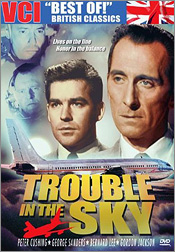 The 1960 film is an engrossing tale about possible pilot error versus flaws in official aircraft company take-of procedures for a modern jet airliner known as the Phoenix. Bernard Lee ("M" in the early James Bond films) plays pilot George Gort whose judgement on an abortive take-off is found at fault by an official inquiry. Peter Cushing is a company inspector who questions Gort's return to duty after being checked out by the airline company's chief trainer, Captain Dallas (played by Michael Craig), who is involved with Gort's daughter Charlotte (Elizabeth Seal). The issue is brought to a head when Gort is involved in a second disastrous take-off, under similar conditions to the first. The film is based on David Beatty's "Cone of Silence" novel which itself drew on real events concerning a European jet airliner of the early 1950s. The British cast is uniformly excellent in imparting suspense and sincerity to the film while creating an air of reality throughout. Many familiar faces are evident beyond the main players including George Sanders as a barrister at the inquiry, and the likes of Andre Morell and Gordon Jackson as other pilots. Peter Cushing takes a break from his Hammer Dracula and Frankenstein outings and cuts quite the figure as the somewhat menacing air inspector. The film's ending is satisfying if a little hurried. VCI delivers the full original British running time of 91 minutes, but unfortunately (apart from the opening credits which are letterboxed) its transfer is full frame as opposed to 2.35:1 scope ratio in which the film was shot. Otherwise, the image does look quite decent with good contrast and image detail throughout. The mono sound is in good shape. There are no supplements. Recommended as a rental. Warner Bros. has given us a fourth box set of Errol Flynn films with its release of TCM Spotlight: Errol Flynn Adventures. 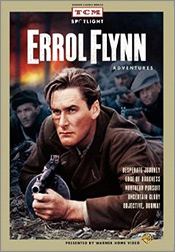 Contained in the set are five wartime dramas. In Desperate Journey (1942), Flynn is the leader of a group of Allied airmen shot down over Germany that tries to make its way back to England. For Edge of Darkness (1943), he's the leader of the resistance in an occupied Norwegian town. In Northern Pursuit (1943), Flynn is in Canada as an RCMP undercover agent trying to unravel the intent of a group of German invaders north of 60. Uncertain Glory (1944) finds him playing a captured French criminal who volunteers to turn himself in to the Germans as a saboteur in order to save the lives of 100 innocent men. And in Objective, Burma! (1945, the only title previously available on DVD), Flynn commands a stranded paratroop patrol in the Southeast Asian jungles. Desperate Journey has long been one of the most-requested of the Flynn titles and it's certainly an entertaining film despite its at-times trying boys-own bravado as embodied by a brash American flier played by Ronald Reagan and frequent Flynn co-star Alan Hale. Its strongest sequences come in the second half during the pursuit approaching and through Holland. Much better films though are the lesser-known Edge of Darkness and Uncertain Glory. Both show Flynn at his very best - playing his parts with a natural, intense style that has stood the test of time exceptionally well. Both films are well-written with strong co-starring work from Ann Sheridan and Paul Lukas respectively. Northern Pursuit, because of its northern setting, is betrayed by its studio-bound roots. That's not to say that it's not exciting, but just when you really get into the story, some back-projection or other contrivance tends to jolt you out of the scene. A jokey sequence tagged on at the end doesn't help either. At least the cast is good with the always reliable Helmut Dantine and Gene Lockhart in prominent roles. Objective, Burma! (aside from the fact that it suggests American troops were winning the war in Southeast Asia, whereas British troops were actually doing the bulk of the heavy lifting there) is an impressive actioner despite its 142-minute length. Aside from Flynn, one of the strengths of all five films is their tight direction. Lewis Milestone who was well known for his war films (All Quiet on the Western Front, The Purple Heart, A Walk in the Sun, Pork Chop Hill) handled Edge of Darkness, while the veteran action expert, Raoul Walsh, directed the other four films. The Warner DVD set gives each film a separate disc and all sport full frame transfers as originally presented. All look very good indeed with contrast and shadow detail particularly strong points. Uncertain Glory though still fine is marginally weaker than the others in these two areas. The Objective, Burma! image seems the same to me as its two earlier releases and looks strong aside from the noticeably inferior nature of its stock footage sequences. The mono sound on all is very good with some slight hiss evident on Objective, Burma! Reminiscent of the glory days of Warner classic DVD releases, each title has been accorded a "Warner Night at the Movies" supplement, in other words an entertaining selection of newsreels, trailers and cartoon, music, and comedy short subjects taken from the same release year as the feature. The inclusion of the previously released Objective, Burma! title in the set is further ameliorated by the addition of an excellent new audio commentary by film historians Rudy Behlmer, Jon Burlingame, and Frank Thompson. Very highly recommended. TCM's first summer Vault Collection release in conjunction with Universal was the five-disc set Deanna Durbin: The Music and Romance Collection. It contains five titles, all originally Universal productions: Mad About Music (1938), That Certain Age (1938), Three Smart Girls Grow Up (1939), Because of Him (1946), and For the Love of Mary (1948). 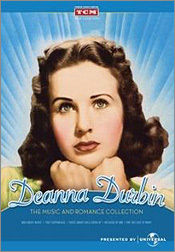
The three 1930s titles offer much the best entertainment in the set and Durbin's naturalness and assured work in each of them makes it apparent why she was such a key performer for Universal during that period. In Mad About Music, she's been sent by her actress mother (Gail Patrick) to a girl's boarding school in Switzerland where she tries to keep her identity secret by inventing a fictitious big-game-hunter father. When her secret threatens to be exposed, she enlists the help of a composer (Herbert Marshall) to pretend to be that father. The stars lend the film more credibility than it really deserves, but everyone is so earnest in their characterizations that one is drawn in despite the silliness of the plot. Durbin gives a nice rendition of "Ave Maria". That Certain Age is a step down from Mad About Music. It finds Deanna and her friends (including boyfriend Jackie Cooper) trying to rehearse for a high school musical revue in her parents' guest house. They are ousted from the guest house when Deanna's father invites a reporter working to a deadline (Melvyn Douglas) to stay there. At first Deanna schemes to drive him away, but she eventually develops a crush on him to her parents' and friends' chagrin. Aside from the predictable plotline, the problem in this film for me is Melvyn Douglas. Deanna's crush on him doesn't seem believable, but then I've never cared for him in any of his film appearances (except perhaps for Mr. Blandings Builds His Dream Home). If you're a Douglas aficionado of course, you may have more patience with the film. Three Smart Girls Grow Up is much better and a good follow-up to the earlier Three Smart Girls. Deanna's matchmaking efforts switch from her estranged parents in the latter to her sisters in the former. This film is a delightful entertainment that zips along, with good supporting work from Nan Grey, Helen Parrish, Robert Cummings, and Charles Winninger. There's a nice rendition of the song "Because" too. The postwar releases Because of Him and For the Love of Mary came late in Durbin's career, with the latter being her final film. In Because of Him, she's a waitress and would-be actress who lands a role in a play with a major Broadway star (Charles Laughton), but her inexperience soon lands her in hot water. The very contrived tale seems to lurch from one plot element to the next sometimes with little rational reason. Still, Durbin's work is appealing even if Laughton's scene-stealing efforts are increasingly annoying at this stage of his career. The songs "Danny Boy" and Rodgers and Hart's "Lover" are featured. For the Love of Mary finds Durbin as a White House telephone operator who breaks her engagement to an attorney (Jeffrey Lynn) in the Justice Department. New romantic entanglements thereafter (Don Taylor and Edmond O'Brien) eventually find even the President trying to play Cupid. The film's essential silliness has it skirting with screwball comedy though it suffers from a cast that can't quite pull it off. Still, as a final film for Durbin, it's not a bad one to go out on. "Moonlight Bay" and "Let Me Call You Sweetheart" are the featured songs. The DVD transfers, all full frame as originally shot, are typically good efforts by Universal. Images are fairly crisp and offer good contrast. Mild to moderate grain is present on all. Mad About Music, That Certain Age, and Because of Him are marginally superior to the others in terms of sharpness and brightness. The mono sound on all titles is in good shape with minimal to no hiss apparent. Each disc sports an introduction by TCM host Robert Osborne, production information from the TCM database, and a selection of publicity photos and posters. Mad About Music adds an interview with John Pasternak and a Deanna Durbin text bio. The five titles are also available individually from TCM, but cost twice as much that way compared to the collection. The collection is recommended. A fine 1954 western from director Allan Dwan, Silver Lode, has been re-released on DVD in a remastered version by VCI. 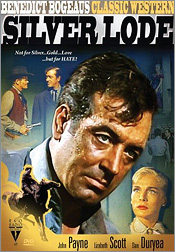
The film is a thinly veiled condemnation of the McCarthy witch-hunts of the 1950s with John Payne forced, on July 4th and his wedding day, to attempt to respond to charges of murder from a supposed federal marshall (named McCarthy! and played by Dan Duryea) who has just ridden into the town of Silver Lode with three deputies. Payne's character, who initially has the support of the entire town, eventually has to stand alone with only his wife-to-be (Lizabeth Scott) and a local saloon girl (Dolores Moran) still on his side. As with many stars of the 30s and 40s, John Payne gravitated in the 1950s towards westerns, a genre he had not previously been much associated with. Rails into Laramie and The Road to Denver were two such efforts as well as a good TV series called The Restless Gun. Payne's work in Silver Lode is somewhat irritating at first as he offers a rather expressionless characterization, but he loosens up in the second half as the film's main action sequences occur. Director Allan Dwan keeps things moving nicely and he builds suspense effectively, leading to a particularly well-shot sweeping sequence of Payne running through the town seeking sanctuary in a church. The RKO production boasts a fine ensemble of familiar western players including Harry Carey Jr., Stuart Whitman, Alan Hale Jr., Morris Ankrum, Myron Healey, Lane Chandler, and others. VCI's new DVD version presents the Silver Lode in Technicolor and full frame as originally shot. It improves on the earlier release with a sharper image and better colour fidelity, removing some of the previous brownish cast. There are still some speckles and scratches, but nothing that detracts from one's enjoyment. The mono sound is in very good shape. Supplements comprise two interesting featurettes (about 10 minutes each) on each of Payne and Dwan, consisting of stills and clips with voice over by Joel Blumberg. For some reason though, the film's theatrical trailer has been dropped from the new release. Recommended. The Serial Squadron has done serial fans a huge favour by making available the 1938 Republic serial, The Lone Ranger. It is delivered on a two-disc DVD-R set. 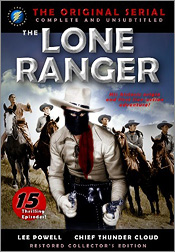
For those who may not be aware of the background, Republic was apparently under contract to destroy the original negative and all existing prints of the serial when its contract expired. This it did, but some partially-altered, foreign-language release versions did survive. As a result, for many years the serial has been available on VHS, but only in an almost unwatchable dupey-looking version with burned-in Spanish subtitles. Now the Serial Squadron, through access to a non-subtitled version of the serial, has issued a DVD release that is the closest approximation available to date on home video to how the serial originally looked and sounded. Some 400 hours of work went into creating the finished project. The serial itself is great fun to watch even if the story seems padded out as many western serials tended to be and also subject to a few weak cliffhanger endings particularly during its first half. In the serial, five lawmen band together against a gang assembled by Jefferies, an outlaw posing as a government tax official who has designs on controlling the state of Texas. One of the lawmen is the survivor of a bloody massacre who was found by the Indian Tonto and nursed back to health. He dons a mask and adopts the identity of "The Lone Ranger", but which of the five lawmen he actually is remains a mystery until the end of the serial. The serial has a great cast of familiar serial and western faces such as Herman Brix (later Bruce Bennett), Lee Powell, Chief Thundercloud, Stanley Andrews, George Letz (later George Montgomery), William Farnum, Hal Taliaferro, Lane Chandler, and John Merton, but its chief merit lies in the typically excellent Republic production values that the studio brought to bear on all its serials and westerns of the time. The stunt work by Yakima Canutt is a constant highlight and the running inserts of the Lone Ranger and Tonto on horseback are among the very best of their kind. Most importantly, the serial is full of action that sustains one's interest throughout the 15 chapters. The Serial Squadron presentation is full frame as originally shot and delivers a satisfactory video and audio experience given the serial's lamentable history. The Squadron provides a realistic outline of what to expect at its website (serialsquadron.com) and its information was for the most part correct. The transfer does not tolerate viewing on larger screens well, as the image becomes increasingly fuzzy with blown-out whites more and more intrusive as progressively tested out on a 20" analog TV, a 37" HDTV, and a 115" projection screen. To be clear, even on a small screen, the serial doesn't look as good as a top quality DVD, but allowing for what might otherwise be available had the Serial Squadron's efforts not been undertaken, the resulting release is very workable. The mono sound is in decent shape; it does seem somewhat hollow at times, but overall clarity is not a problem. The only supplement is a gallery of poster and still art. Recommended for anyone who has long wanted a decent copy of this serial. The Serial Squadron has similarly delivered a fine restoration of the 1939 Republic serial, The Lone Ranger Rides Again. 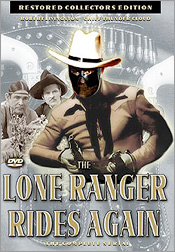
This serial's history is similar to that of The Lone Ranger, in that the original negative and all prints were destroyed by Republic per its contractual obligations. Again, a foreign print with burned-in Spanish subtitles survived. The Squadron had only this version to work with, making its efforts even more labour intensive as a result of the desire to remove all such subtitles. The technique used involved borrowing visual information from existing unsubtitled frames. Sometimes the results are seamless, while in other instances there are some artifacts evident or even some minor letterboxing necessary where extra-long subtitles were involved. Chapter openings, title cards, end titles, and the like have also been fully restored or re-created for this edition (as many had been removed from the surviving print). The full frame image on the Squadron's DVD-R two-disc presentation is better than that of The Lone Ranger in respect to blown-out whites and sharpness, but is much more ragged looking in terms of numerous speckles and scratches. Overall, it tolerates somewhat larger viewing screens more satisfactorily than does The Lone Ranger. The mono sound apparently underwent considerable noise reduction and the results are also satisfactory. Supplements include an entertaining half-hour commentary on the serial by members of the Serial Squadron as recorded at SerialFest 2007; a presentation of the unrestored version of the serial ending; a short Lone Ranger cartoon; and a trailer for the silent The Masked Rider serial now available on DVD from the Squadron. As for The Lone Ranger Rides Again serial itself, any serial that stars Robert Livingston and Duncan Renaldo can't be all bad. On the other hand, the story is the rather generic homesteaders vs. ranchers standoff and it lacks any compelling villains such as in the Roy Barcroft mold. Chief Thundercloud does return as Tonto, but the inclusion of the Duncan Renaldo character as effectively a sidekick to the Lone Ranger makes the production more reminiscent of a trio B western such as those of the Three Mesquiteers or the Range Busters than a heroic Lone Ranger tale. Overall, it's not bad as middle-of-the-road serial entertainment, but it doesn't measure up to the original in terms of action and excitement. Still, given the serial's provenance as far as home video is concerned, the release is certainly recommended for serial fans. The 1959 Clint Walker western, Yellowstone Kelly, has been released in a remastered edition by the Warner Archive. 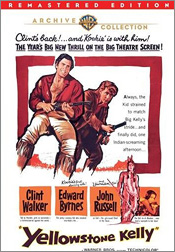
The film recounts a sturdy though fairly familiar tale. It's soon after the time of the Battle of the Little Big Horn and the army is intent on pushing the Sioux back into the Dakotas. Walker plays trapper Yellowstone Kelly who has worked Sioux territory for many years in safety because he saved the live of a Sioux chief (John Russell). He saves the life of a beautiful young Arapaho woman who has been captured by the Sioux. When she tries to escape from the Sioux, Kelly gives her shelter but then finds himself and a young admirer that he's agreed to take on as a partner (Edward Byrnes) at the centre of the developing conflict between the Sioux and the cavalry. The film draws heavily on the Warner Bros. stock western TV company of the time and generally to good effect. Walker is particularly strong as the lead, his considerable stature and earnest performance lending significant dignity to his role. Russell fares similarly in his Sioux chief portrayal. Even Ed Byrnes offers an earnest effort in a role that reminds one of Ricky Nelson's contribution to Rio Bravo. The film has some well-staged action sequences and really takes fine advantage of its Sedona locations to deliver a very handsome outdoor production. There's certainly nothing extraordinary on display here, but it's a very amiable hour and a half's entertainment. The Warner Archive presentation delivers a very nice 1.85:1 anamorphic image. It's crisp and the Technicolor image is quite vibrant with good fidelity. Some scenes seem a little dark, but that's the only quibble I have. A fine layer of grain is fairly consistent throughout. The mono sound is good shape. There are no supplements. Recommended. There was a long hiatus after the appearance of the first three seasons of Have Gun - Will Travel on DVD, but Paramount did promise that it would return to the series. 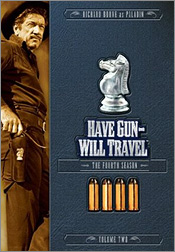
Now true to its word, 2010 has brought us The Fourth Season, albeit in two separate releases Volume One was released this past winter and now we have Volume Two. Nothing has changed in the fourth season. Richard Boone is still the likable and charismatic Paladin, a man of refined taste and a gunfighter for hire from his base in San Francisco. The stories are still of considerable interest, mostly dramatic but some with comedic tones and cast with a fine array of supporting players. The series continued to be very popular during its fourth broadcast season and would only start to slip slightly in the ratings in its fifth and sixth (final) seasons. Some of Paladin's tasks in the second half of the fourth season include dealing with a man involved in Lincoln's assassination, collecting taxes from cattle-rustlers, acting as a lawyer for a doctor accused of murder, dealing with an alcoholic Calamity Jane, and looking after a prisoner who's a bible-quoting psychopath. Among the supporting players of note in the second half of the fourth season were William Talman, Royal Dano, Allyn Joslyn, Harold Stone, Leo Gordon, Roy Barcroft, Buddy Ebsen, Scott Marlowe, Eduard Franz, Frank Ferguson, George Kennedy, Werner Klemperer, and Ken Curtis. Paramount's DVD presentation is similar to that of the fourth season's first volume - 19 half-hour episodes on three discs. Episode summaries are provided on the back of the case's paper cover, although they don't identify episode guest stars like they did on previous releases. The image (full frame as originally broadcast) quality is consistent with that of the season's first volume - sharp with impressive contrast and only the very odd speckle or scratch to detract from an otherwise seemingly pristine look. The mono sound is in very good shape. There are no supplements. Recommended. At a time when Sean Connery was frustrated enough with the James Bond films that he had dropped out of the series, he was enticed by United Artists to return to do Diamonds are Forever with the promise that the company would finance another film of Connery's choice. That choice was 1973's The Offence, based on a stage play of the same title by John Hopkins. 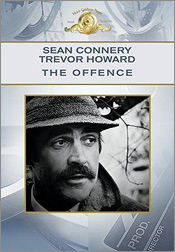
The film has now been released on DVD-R by MGM in association with Create Space as part of its program of manufactured-on-demand (MOD) releases. At its simplest, the film is a tale of police brutality, but in reality it delves deeply into the effect that years of exposure to violent and sickening crimes have had on a 20-year veteran of the London police force. The story revolves around a beating administered to a suspected child molester while being interrogated by that officer, Detective Sergeant Johnson (Connery). As directed by Sidney Lumet, the film offers constant surprise in its narrative structure and in the direction the story takes us. The opening sequence is effectively filmed against a piercing background score with much of the action partially obscured by the reflection of an overhead interrogation light. By the time the film ends almost 2 hours later, we have circled right back to the same scene, but the revelations in between are surprising and even shocking. Connery's portrayal of the troubled Johnson is superb, ranging from angry brutality to quiet sadness, but mainly a balancing act of barely-controlled fury. Contributing an amazing performance is Vivien Merchant in a brief appearance as Johnson's wife. Her character is assaulted verbally by Johnson in as brutal a fashion as if he had physically beaten her and Merchant's nuanced portrayal of a woman who wants to listen but finds herself unable to stomach what she hears is memorable long after the film ends. Also contributing strong work are Ian Bannen as the accused molester and Trevor Howard as a senior police officer assigned to get Johnson's side of the story. The film certainly reflects its stage origins, particularly in the second half, but Lumet does open it up effectively during the surveillance and search scenes during the early going. The overall result is an entrancing experience well worth the investment of time. MGM's MOD release is presented on DVD-R with a 1.85:1 anamorphic transfer that's quite pleasing. The image captures the film's drab colours of a 1970s England accurately and with considerable detail. Sharpness is quite good and there's no significant evidence of edge effects or other digital sharpening. The mono sound is clear. There are no supplements, nor even an opening menu. After the UA logo, the film simply starts. Recommended. While calling it the "holy grail of missing noir films" as the package advertising would have one believe seems somewhat excessive, VCI's release of 1955's New York Confidential (an Edward Small production distributed by Warner Bros.) is very welcome indeed. 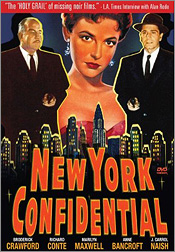
The film, an exposť of syndicate operations in New York including its tentacles reaching into Washington politics, is a real crackerjack of an entertainment, full of fine performances from the leads (Broderick Crawford, Richard Conte, Ann Bancroft) right through the raft of familiar supporting players (Mike Mazurki, John Doucette, Onslow Stevens, Bill Phillips, and so on). Broderick's crime boss Charlie Lupo is a sight to behold - a man in constant motion verbally and physically, who is well contrasted by the quiet competence and intensity of Richard Conte's imported hit man - an almost sympathetic character whose likely fate we almost hope won't come to pass. The film also provides a good early opportunity for Anne Bancroft as Lupo's rebellious daughter. Unlike many of the noirs of the time, New York Confidential was completely filmed on the back lot without much photographic flair, but it manages to be fairly atmospheric nonetheless. Its action sequences pull few punches and communicate the violent world of organized crime quite effectively, and the film even offers some fairly overt sexual innuendo. There were a number crime exposť type films in the 1950s; if you haven't seen any of them, New York Confidential is one of the best places to start. The film has apparently been out of circulation for several decades, but Kit Parker Films recently cleared some rights issues allowing VCI to release it on DVD in a nice restoration of the original negative. The 1.85:1 anamorphic image is quite crisp for the most part with good attendant shadow detail. A few night-time scenes are a little murky. Grain is evident but never excessive. The mono sound is quite clear. Supplements include a very informative audio commentary dominated by film historian Alan Rode with the participation of film writer Kim Morgan, the theatrical trailer, a before and after restoration comparison, and an advertising gallery. Highly recommended. Virtually anyone who's a regular viewer of TCM will have at one time or another seen one of the "All-Barkie" shorts. Produced by MGM very early in the sound era, these Dogville two-reelers featured casts of exclusively dogs in imaginatively-conceived satires of the major movies and movie genres of the day. The Warner Archive has now gathered together all nine of these shorts and released them on a two-disc DVD-R set titled simply Dogville Collection. 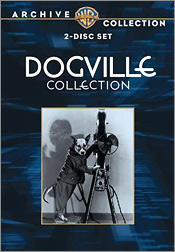
The shorts were conceived and directed by Zion Myers and Jules White, and featured dozens of dogs of all breeds and sizes. Each dog was creatively costumed for the particular role it was playing, reflecting all the major clothing styles of the day and showing considerable attention to detail in their authenticity. The visual sequences were shot first and all dialogue was recorded and added later. As mentioned, the shorts generally spoofed movies of the time. So we get the likes of The Dogway Melody (The Broadway Melody), The Big Dog House (The Big House), Trader Hound (Trader Horn), and So Quiet on the Canine Front (All Quiet on the Western Front). Or we get pastiches of the elements of genre films of the time - for example College Hounds with a character known Red Mange spoofs the numerous college football films; Two Barks Brothers is a take on the familiar story of the two brothers who end up on opposite sides of the law (such as in the later Manhattan Melodrama); and Who Killed Rover? (sometimes known as The Dogville Murder Case) with a dog character known as Phido Vance spoofed the many detective films of the time. The dogs used were well-trained animals, but even so the constant walking on hind legs and unusual poses calling for the use of wires raised concern about the animals' treatment. Animal welfare agencies of the time apparently found no cause for concern, yet one wonders. Nevertheless, the results were certainly entertaining, even side-splitting at times. One can watch several of these at a time, but they're best viewed in single doses, as an accompaniment to a viewing of the corresponding real feature of the time. The Warner set offers very workable transfers. The images are usually quite sharp and have decent shadow detail. There is inevitable wear and tear in the form of speckles and scratches, but nothing that detracts from the viewing enjoyment. The mono dialogue is in good shape and it's worth paying close attention to, as much of the background dialogue gives the stories a heightened atmosphere of reality. There are no extras. Recommended. |
on to Page Two
 |
| Site
designed for 1024 x 768 resolution, using 16M colors and .gif 89a
animation. © 1997-2015 The Digital Bits, Inc., All Rights Reserved. billhunt@thedigitalbits.com |